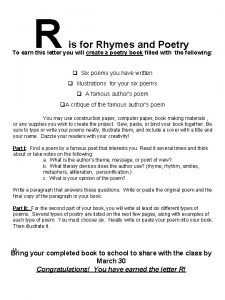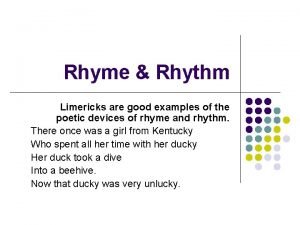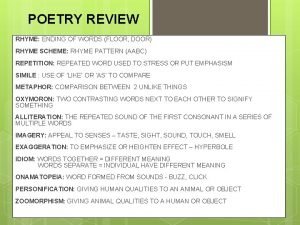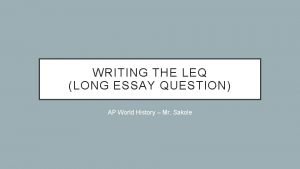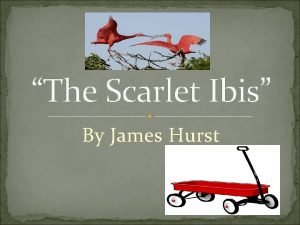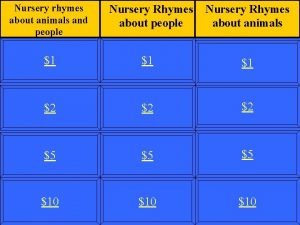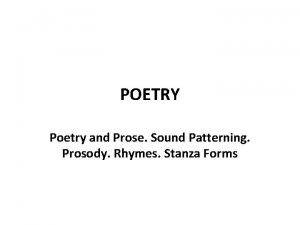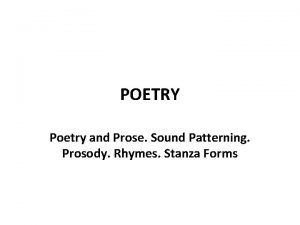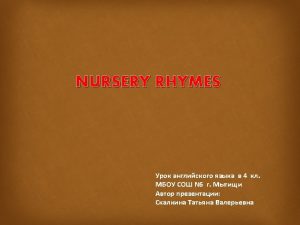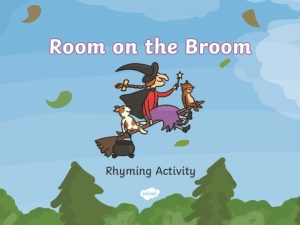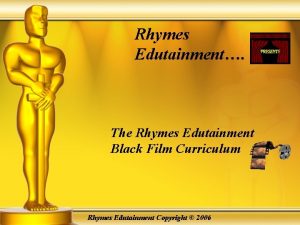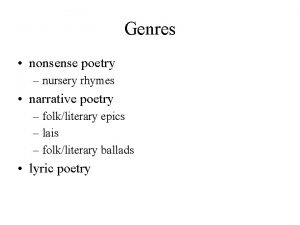R is for Rhymes and Poetry To earn









- Slides: 9

R is for Rhymes and Poetry To earn this letter you will create a poetry book filled with the following: q Six poems you have written q Illustrations for your six poems q A famous author’s poem q. A critique of the famous author’s poem You may use construction paper, computer paper, book making materials , or any supplies you wish to create the project. Sew, paste, or bind your book together. Be sure to type or write your poems neatly, illustrate them, and include a cover with a title and your name. Dazzle your readers with your creativity! Part I: Find a poem by a famous poet that interests you. Read it several times and think about or take notes on the following: a. What is the author’s theme, message, or point of view? b. What literary devices does the author use? (rhyme, rhythm, similes, metaphors, alliteration, personification. ) c. What is your opinion of the poem? Write a paragraph that answers these questions. Write or paste the original poem and the final copy of the paragraph in your book. Part II: For the second part of your book, you will write at least six different types of poems. Several types of poetry are listed on the next few pages, along with examples of each type of poem. You must choose six. Neatly write or paste your poem into your book. Then illustrate it. th Bring your completed book to school to share with the class by March 30 Congratulations! You have earned the letter R!

What is Poetry? Poetry is language used in a special way. A poet chooses words to help you understand feelings and ideas. Good poetry will excite your senses: you can hear sounds and see pictures in your mind when you read. Poetry can inspire your imagination and teach you to think creatively! There are many different types of poems. Several examples are highlighted on the next few pages Cinquain A cinquain is a 5 -line, unrhymed poem. It begins with a subject followed by two descriptive words (adjectives), three action words (verbs), a phrase or sentence describing the subject, and a word that means the same (synonym) as the subject. Planet Enormous, ringed Spinning, whirling, twirling A most majestic sight. Saturn. Noun Adjective Verb Phrase or sentence Synonym Verb

Ode An ode is a poem that tells about a subject and why the writer likes it so much. Odes can be rhymed or unrhymed. They do not have to have a set rhythm pattern. Ode to My Feet Ode to Chocolate Feet, oh feet, I simply cherish you, You help me in every thing that I do. Feet, oh feet, you enable me to run When I lay down you take a break - have fun! Ode to chocolate So so yummy. Ode to chocolate In my tummy. Your adorable, short, stumpy toes help me balance, How I idolize you and your so many talents. Your tiny toenails are fun to decorate, I enjoy putting glitter on them - they're also fun to paint. My affectionate feelings for your ability to transport me to different places, Always bring a shock to other people's faces. So now you know exactly how much I prize you, my dear For you my idol, I will always cheer. Ode to candy bars Kit Kats and Milky Mays Ode to hot chocolate On the coldest of days. Ode to the chocolate So rich and so pure I’m a choc-o-holic And there is no cure!

Haiku poems originated in Japan. The Japanese people have a great appreciation for beauty and nature. Japanese poets write haiku to celebrate their love for plants and animals, water, and the changing earth around them. Haiku poems have three unrhymed lines. The first line has 5 syllables and tells the location or where the poem takes place. The second line has 7 syllables and tells what is happening. The third line has 5 syllables and tells when the poem takes place. 5 syllables, (where) Through the green tall grass, The great tiger hunts his prey, 7 syllables (what) In the still of night. 5 syllables (when) Diamante A Diamante is a 7 line, diamond shaped poem. Its lines do not rhyme. It begins with a subject followed by a pattern of seven words that describe the subject. The last seven words describe the opposite of the subject. The final line is the opposite word. Look at how the pattern words in this poem: subject Sun adjective Bright, shiny adjective verb Glistening, twinkling, warming noun Gases, flares, craters, mountains noun verb Glowing, romancing, forbidding adjective Mysterious, faraway Opposite subject Moon noun

Limericks A limerick is a humorous 5 line poem. They originated in the city of Limerick, Ireland. Some limericks are silly and use nonsense words. The limerick used the AABBA pattern of rhyming. That means that the 1 st 2 nd, and 5 th lines rhyme with each other. The 3 rd and 4 th lines rhyme with each other. All the A lines rhyme and all the B lines rhyme. The rhythm pattern is written in feet (groups of 2 or 3 syllables. ) Each rhyming line has the same number of syllables. A A B B A There was a Young Lady of Bute, (8 syllables, 4 feet) Who played on a silver-gilt flute; (8 syllables, 4 feet) She played several jigs (6 syllables, 3 feet) To her uncle’s white pigs, (6 syllables, 3 feet) That amusing Young Lady of Bute. (8 syllables, 4 feet) Here are examples of other limericks: There was an Old Person of Ware Who rode on the back of a bear When they asked, “Does he trot? ” He said, “Certainly not. He’s a Moppiskon Floppiskon bear!” There once was a man named Jane Who really hated his name ‘Til he met a young gal With the odd name of Sal His life was never the same.

Ballad A ballad is a story in verse. Thousands of years ago people told ballads and performed them with folk dances. Heroes or legends are usually the subject of ballads. The English outlaw Robin Hood, the American railroad engineer Casey Jones, and the American steel driver John Henry are a few legendary ballad subjects. A ballad is made up of stanzas of a group of lines that go together. Each stanza is a quatrain (four lines) and follows a rhyming pattern. A popular pattern in ballads in A B C B. The first and third lines do not rhyme, while the second and fourth lines do. There is no set rhythm pattern. This means the number of syllables in the lines might be different. Here is an example of a ballad: A John Henry was a little baby, B Sit-n’ on his mama’s knee, C Said, “The Big Bend Tunnel on the ol’ Road B Gonna be the death of me. ” A B C B The captain says to big John Henry Gonna bring a steam drill round. Gonna take a poew’ful drill out on the job. Gonna whop that drill on down. A B C B John Henry sang to his shaker, Shaker life you voice and sing. I’m throw’n my hammer from my waist down. Listen, hear the cold steel ring. A John Henry hammered on the mountain B Saw his hammer strikin’ fire. C Yes, John Henry drove so hard he broke his heart, B Dropped his hammer, then he did expire The Ballad of Mrs. Smith was only the age ten When her parents said, “We’re moving west. ” They packed their bags and moved their things But do you know the rest? They settled in a place on top of a hill A long way from the Empire state. It was sure different from where they were from But soon they thought it was great! Mrs. S. moved away and learned to teach And then came back to where she had grown And then she started to teach 4 rd grade At the best school ever known!

Free Verse is a poem with a set pattern. The lines are divided according to the natural patterns of speech instead of following a meter or rhythm pattern. Here is a Free Verse poem by Hilda Conklin: Little Snail I saw a snail Come down the garden walk, He wagged his head this way…that way… Like a clown in a circus. He looked from side to side As though he were in a different country. I have always said he carries his house on his back… Today in the rain I saw that it was his umbrella. Here is another example of a free verse poem: Funny the way Different cars start Some with a chunk and a jerk Some with a cough and puff of smoke Out of the back, Some with only a little click-with hardly any noise. Funny the way Different cars run. Some rattle and bang, Some whirr, Some knock and knock Some purr And hummmmm Smoothly on which hardly any noise.

Prepositional Poems In a prepositional poem every line starts with a preposition. Here is an example of a Prepositional Poem: On the driveway Past the barn Over the stream In the house Down the hallway Past the kitchen In den Out the back door In the pool Between the drain Lies my 24 karat gold ring. Here is another example of a prepositional poem: Over the hill Past the city Through the tunnel Into the forest Between the trees Under a fallen log Towards the tornado In the twister Up, into the heavens Through the middle of a cloud Past the sun In space Is my wallet!! Acrostic Poems Acrostics are poems whose first letters of each line spell a word vertically. There is not a set number of lines in an acrostic poem. An acrostic poem may be about any subject. Read this example of an acrostic. SCHOOL Starting in September Children gather to learn Hours of playing and learning Open books and desks Outside fun for all Lasting knowledge

Alliteration and Onomatopoeia Alliteration and onomatopoeia are called poetic devices. They are a method to use words and sounds for effect in a poem. Try using these poetic devices in your poems! Alliteration is the repetition of a beginning sound for effect. The alligator ate only apples and avocados. Brown bears burrow below boulders Onomatopoeia is the imitation of natural sounds. For example: The steam hisses from the open valve. Onomatopoeia is a poetic device that produces an auditory image to the reader. The train rumbled down the track. The trucks brakes screeched in the distance.
